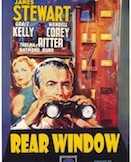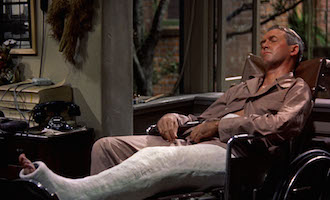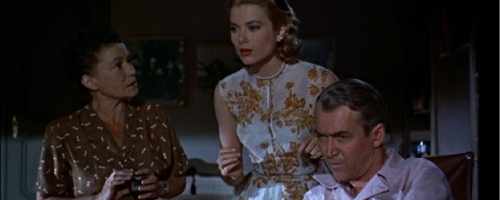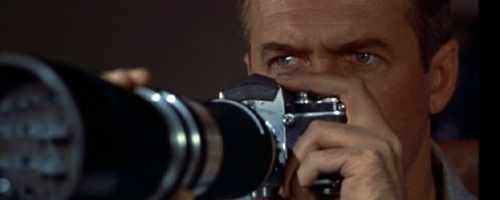Hitchcock’s Rear Window (1954): The Limited Perspective of the Voyeur
Alfred Hitchcock’s 1954 thriller Rear Window encapsulates his masterful use of controlling information to create deep-seated suspense in the audience. James Stewart plays L.B. Jefferies, a photographer bound to a wheelchair in his apartment as his broken leg heals. He finds himself in a world in which his perception is limited to the apartment complex outside his window. The summer days grow long and the stifling heat causes the tenants of Jefferies’ complex to open their windows and reveal the story of their lives to Jefferies as he watches unseen from his rear window.

Each window opens a unique narrative to Jefferies; he even gives the characters titles as he follows their lives. There is Miss Torso, a beautiful dancer, Miss Lonely Hearts, a loveless bachelorette, a young newlywed couple, a songwriter and most notably a salesman living with his bedridden wife. Jefferies shares the stories he observes with his girlfriend, Lisa, played by Grace Kelly. Jefferies, Lisa and the house nurse, Thelma, find themselves engrossed in Jefferies speculations regarding a murder plot involving the salesman, Lars Thorwald, and his wife.
Jefferies tirelessly stares out his window, marking every movement of Lars after Mrs Thorwald mysteriously disappears. Despite Jefferies’ friend, Doyle the detective, attempting to convince Jeffreies that his plot is an imagined tale, Jefferies tenaciously observes Lars day and night from his rear window. After collecting piles of “hard” evidence including Lars’ strange, late-night walks, a dead dog, mysterious long-distance phone calls, suspicious jewelry and a handbag, the amateur sleuth trio decide to investigate further, resulting in Jefferies’ hidden vantage point being revealed. Lars ventures to Jefferies’ apartment and after a failed attempt to throw Jefferies from the rear window, he confesses to the police that he did indeed murder his wife.
By maintaining the voyeuristic point of view from the rear window of Jefferies’ apartment, the audience views the same events that Jefferies stumbles upon from the same limited perspective. Hitchcock is the renowned “master of suspense” because of his expert use of revealing just enough information to the audience to keep them on the edge of their seat as events unfold in the movie’s narrative. Because the viewer knows as much as Jefferies does, they are forced to make their own conclusions regarding this mysterious murder plot. They must decide if they will believe Jefferies, in which case Lars’ apartment across the courtyard lurks ominously as a scene of a gruesome murder, or follow the advice of Doyle and believe the entire story is the figment of a stagnant imagination.

Hitchcock is known for using the thematic element of mistaken or misguided identities in his film to create twists and turns as well as suspense in his narratives. In his eerie psychological thriller, Psycho, he portrays Norman Bates as a polite, reserved individual. As we know Norman turns out to be quite the opposite: a deranged psychopath. In North by Northwest the main character is mistaken for a government agent and becomes the target of both the government and spies. Rear Window is no different; Lars is identified quite quickly as a murderer, but that identity is what is in question throughout the film. It is this idea that pushes the plot of the movie forward and creates conflicting theories among the characters as well as the audience viewing the film.
The historical context of the film brings up another intriguing aspect of Hitchcock’s vision for Rear Window. Between 1950 and 1955 the age of Mccarthyism was in full swing. The United States was in a communist scare. Friends threw friends under the bus to save their own skin, neighbors turned on neighbors; suspicion ran rampant. It seems reasonable to assume Hitchcock was inspired by the social strife in America during this period as he directed Rear Window. One neighbor speculating about another committing terrible actions is very reminiscent of the attitude of many Americans during the early 1950’s.

Unlike a vast majority of films portraying cinematic worlds with numerous settings and diverse sets, Hitchcock’s Rear Window does an incredible job of creating a minimalist cinematic world within the confines of a single apartment complex. The camera’s gaze never leaves Jefferies’ apartment or the courtyard outside his window.
The opening and closing shots of the film take on a cyclical nature in terms of presenting the entire world of the film to the viewer. The movie begins as the blinds of Jefferies’ windows rise, revealing the apartment complex beyond. The camera slowly zooms forward to the ledge of the window frame to convey Jefferies’ view throughout the entire movie. After a brief cut to a close-up shot of a thermometer reading over ninety degrees, conveying the stifling heat of the season as well as foreshadowing imminent tension, the camera pans around the entirety of the apartment complex. This pan shows wide-open window frames in which Jefferies’ “characters” go about their daily actions. The viewer receives a sense of every miniature narrative observed by Jefferies. Each window literally frames these characters with a medium shot. This medium shot allows the viewer to perceive what the character’s actions are as well as the relationships or lack-there-of..
In a sense this panning shot conveys many separate cinematic worlds within a grander world, the apartment complex. Each window frame is essentially a narrative within the larger narrative. Each character plays the central role within their own small story, viewed by Jefferies, Lisa, and Thelma. Each narrative is it’s own separate entity. The narratives very rarely overlap; the neighbors seldom interact with each other.

Only a catastrophic event brings each framed story together into the overarching world of the apartment complex. For example, the first time every tenant of the complex interacts together is when the dog is mysteriously killed. Everyone races to their windows to watch as the dog’s owner mourns. “Didja kill him because he liked ya?” the woman yells into the night, addressing the community as a whole. The next example is when Lars is pushing Jefferies out his window. The scene appears to fast-forward as the tenants race to their windows to see the action. This sped up action conveys the stress within the community and the cinematic world as a whole.
The way we view the world of the apartment complex changes as Jefferies utilizes different methods of gazing into the windows surrounding him. Specific aspects of the world become magnified as Jefferies uses his photography tools. We are given close-up and extreme close-up shots as he looks through his camera’s telescopic lens. His binoculars give us more of a medium close-up shot. Each tool gives us the advantage of being able to see specific objects, actions and emotions in more detail while also narrowing our gaze within the world.
When a character leaves the complex, such as Lars as he walks mysteriously into the night through the narrow alleyway, they essentially exit the cinematic world all together, like exiting a stage. We have no way of knowing where they are going or what they are doing. When they leave our gaze, their narrative pauses until they return to the complex.
It seems notable that Jefferies is a traveling photographer. He has made a career of capturing images from all over the world. He never seems to go to the same place, something new and intriguing always calls to him. So when he is confined to viewing the apartment complex around him, it becomes the entire world to him. He makes do with what he is given and observes every aspect of his world. In turn the viewer is given glimpses into the lives of half a dozen other people. With the turn of Jefferies’ head he can move from one world to another, one window frame to another.

The world within the apartment complex is even given it’s own diagetic soundtrack through the constant practicing of the songwriter living near Jefferies. If the songwriter isn’t playing the piano alone or with his band, he is playing music on his record player. The music in the background of the action observed by Jefferies rarely, if ever, matches what’s happening on screen. An intense moment may have a lighthearted soundtrack because the music is an aspect within the cinematic world and the songwriter doesn’t play for the events we see in the film.
The closing scene of the film directly corresponds with the series of shots from the introduction. The camera zooms to the edge of the windowsill in Jefferies’ apartment to view the complex. The shot cuts to a close-up of the thermometer, this time it reads around seventy degrees. This tolerable temperature signifies a cooling of the tension in the film as it comes to a close and the ending of the summer. The camera cuts to a pan of the complex to show us the same characters we followed during the film. Each narrative is given it’s own closure: a new dog is introduced, Miss Lonely hearts is visiting with the songwriter, Miss Torso’s boyfriend comes home from the army, and Lars’ apartment is being painted over to get ready for new tenants. The final shot of the film shows the blinds of the rear window closing, hiding the cinematic world as the film draws to a close.
Hitchock created something very special with Rear Window. He takes the notion of narrative perspective and exaggerates it by creating an invalid character without the ability to leave his apartment. We see what Jefferies sees, nothing more or less. Hithcock’s artful approach to what information the viewers should or should not be given shows his mastery of suspense and ability to make an audience identify with his characters but it also shows his ability to make an audience question even their own notion of the truth.
What do you think? Leave a comment.










Rear Window might just be the most tedious film I have ever seen. It only begins to get its act together at the one and a half hour mark, but by then the film has only twenty more minutes to go. The ending is rushed, and while momentarily suspenseful, very predictable.
I agree with you about the story and it’s predictability, but I think it’s an interesting representation of the voyeuristic quality of being an audience member for a film. If we were involved in the story in front of us, we wouldn’t enjoy it as much. I think Hitchcock was trying to express that notion. The story works well enough but I think it’s trying to do something more than that.
One thing that makes this such a great 50’s film is, that was the decade that TV was destroying the movies. So what Hitchcock did was create a set that’s essentially a bunch of little TV screens. Interesting comment on the times.
I most definitely agree that Rear Window provides a comment on the rise of TV in the 50s and that it’s windows are “little TV screens”. It is especially relevant today given our 21st century cultural obsession with transparency in government, media and business. We expect to be able to see all aspects of everything–we now have many more Windows–when in fact this film reminds us of how our perspective and knowledge is ultimately limited. What is exciting and arguably most worth knowing is just beyond what we can see.
A beautifully directed, fascinating story with a nostalgic glimpse of what it was like living close together without air-conditioning in the early fifties.
the acting was good and the idea was obviously original…. but i was expecting more.
Interesting analyses. I liked this classic film but I thought Dial M for Murder was better than this and believe this is very overrated, although I found it enjoyable.
As I said in my response to Lowell, I agree the film isn’t necessarily his masterpiece of story telling, but I do think it’s an interesting analysis of audience as voyeur.
I was waiting for Jeffries to get his comeuppance… his behavior and leaps in logic were annoying to watch… and the movie ends with him being right…
I totally agree. His blatant speculation kind of got on my nerves too. But isn’t that how a lot of people behave? People pass face-value judgements every day. It just so happens that this time it was true.
Rear Window is one of the best, but two of my absolute favorites (and certainly two of the best of the 50s); Vertigo and The Searchers!
Just watched Vertigo the other day and YES! I can see why it would be one of your favorites. Something I noticed about it was the very frequent use of extreme longshots. This style of shooting is extremely reminiscent of the way Scottie describes what induces his vertigo, like a pencil falling to the floor. A small object from far away and high up. Could the camera angle be a way of giving the audience a sense of Scotty’s vertigo?
The 50s was a great decade for movies.
I love how Hitchcock can play with the audience. He does the “limited perspective” trick a lot with his key characters, leaving us as clueless as the protagonist. I never thought about it much before reading this, so thanks for making me think!
I completely agree. Limited perspective, paired with a masterful use of setting, allow for a very intriguing plot structure. A great film to make a great time period.
For the life of me I cannot like this movie. I enjoy a good slow burning tension building film more than action packed or jump scare ones. But this was just ridiculous. I reeeeeaaaaalllly don’t want to use the “B” word, but, and let the bashing begin, this movie was boring. If it were chopped up a tiny bit, like say, shave 20-25 minutes off of it, it would’ve been a better movie. Alas, it surely has it’s good points though. I just feel the hour and a half straight of literally nothing happening to be a bit excessive. I know I am not the only one to feel this way. But I’m sure I will get bombarded with Hitchcock purists who will bash my post to death. Please save yourself the trouble of saying “you must be a youngster…..” age has nothing to do with whether someone enjoys or doesn’t enjoy a movie where literally nothing happens for 90% of it. And lets be honest….NOTHING happens, changes…it’s a man in a room. I don’t see the brilliance. I love Psycho, Birds, Vertigo…..but I just don’t like this one and that should be fine to you folks. Just my $.02
At least you’re not calling it overrated or worse garbage.
Personally, I prefer it to Vertigo. Vertigo is too stylish and the age difference between the leads is distracting for me. It’s as entertaining as The Birds (which I think is kind of schlocky in a good way) but not as good as Psycho.
Sometimes I think people just go “Well, it’s Hitchcock, so it’s gotta be great!”
I’d agree that this movie’s high point isn’t really the narrative or the plot. What I think is great about it is the use of lenses (literally and figuratively). It seems to me like it’s a (and bare with me here) meta analysis of the limited perspective of a film. We see only what the camera shows us. We only see what Jefferies’ camera sees.
If I had to choose a favorite Hitchcock film of my viewings of his collection so far I’d pick “North by Northwest”. I think it features one of the best lead characters he’s directed. It seems like someone took a James Bond flick and morphed it into something 10 times better.
I just watched this movie, and I have to say that it is a very good movie. Although it has several mistakes or things that wouldn’t be made today.
I had recently watched Haneke’s Caché and was instantly reminded of this film. While Caché utilized the themes of voyeurism to a darker (and creepier) extreme, the first person perspective definitely share similarities.
One thing I particularly liked about Rear Window was the vitality of every neighbor. While characters like Ms. Torso and Songwriter are not directly involved with the murder, they each have fully formed narratives.
I think I have grown more and more taken by the fact that this entire film was shot on a single, yet enormous set; which actually had to be built into the two story-deep basement of the sound stage it was constructed on in order to accommodate the 4 and 5 story tall buildings on the lot.
Initially I had believed that the location was a real location, but upon realizing it was a set only adds to the masterful hand of Hitchcock at work: being able to manipulate every aspect of his film; even going so far as to create buildings, each with their own character, and being able to control when the sun rises and sets. Now that’s what I call creative power.
Yes! Exactly.
I always wonder if Hitchcock read Georges Simenon, especially the Engagement, a great detective story about voyeurism and death.
Great stuff, Greg! I always enjoy reading analyses on filming techniques and set designs. If you haven’t already, you should really check out Laura Mulvey; her analysis of film, and Hitchcock’s techniques, are quite interesting.
The first article I’ve read to equate the type of lens used on the actual camera to what Jimmy Stewart’s character himself is specifically seeing (be it with his naked eye or his own camera). This is one of the films that Hitchcock is experimenting with the power of cinema and what it can do, and for me, ranks with his best (those being Vertigo, North by Northwest, Psycho, and maybe his best and definitely the most overlooked, Marnie).
How did Lars Thorwal know Jeffries’ phone number?
Thorwal himself only discovered Jeffries was the one who was onto him once he caught Lisa gesturing across the courtyard that she had the wife’s ring.
Only seconds later did Jeffries receive the phone call. (So Thorwal did not have the time to go to Jeffries building, see his name on the mailbox and go back home to make the phone call.)
I guess it’s just a plot hole, but it snags me every time I watch it.
This was good, helped me with my english essay